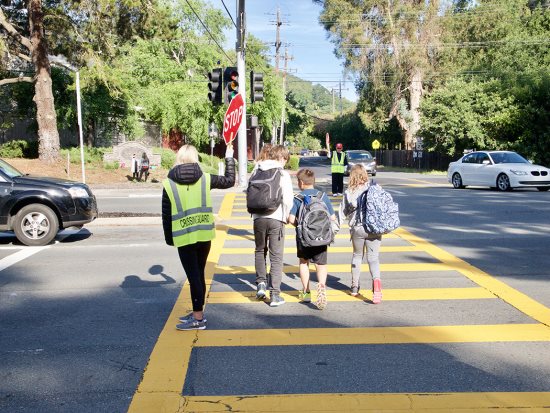 | | | Crossing guards at the busy Springhill Road intersection last year. Photo Pippa Fisher | | | | | | The city council voted unanimously, minus Council Member Susan Candell who was absent, at its Jan. 14 meeting to increase participation in funding for the school district's crossing guards to a rate of 50 percent.
 The city historically split the costs 50/50 until fiscal year 2015-16 when the contract was turned over to the district to manage. The city continued to pay a flat amount of $50,000, roughly half the cost at the time. However, with inflation and the addition of four extra guards, costs have ballooned over the past four years to $179,453.
The city historically split the costs 50/50 until fiscal year 2015-16 when the contract was turned over to the district to manage. The city continued to pay a flat amount of $50,000, roughly half the cost at the time. However, with inflation and the addition of four extra guards, costs have ballooned over the past four years to $179,453.
 Even accounting for the increase of personnel, the average annual rate of increase per year is 3.8 percent. The four extra guards were added in 2015-16 as a response to a couple of incidents involving students hit by cars.
Even accounting for the increase of personnel, the average annual rate of increase per year is 3.8 percent. The four extra guards were added in 2015-16 as a response to a couple of incidents involving students hit by cars.
 Lafayette School District Superintendent of Education Richard Whitmore made the point that while dwindling state funding challenges the district, the crossing guards are on the front line for safety of children and he highlighted this as a priority.
Lafayette School District Superintendent of Education Richard Whitmore made the point that while dwindling state funding challenges the district, the crossing guards are on the front line for safety of children and he highlighted this as a priority.
 Mayor Cam Burks says that the council's decision to increase funding to support the crossing guard program signals the first of many collaborative steps it will take this year in partnering with schools to ensure the "Green Hills, Great Schools" city motto - and community imperative - is sustainable and strong.
Mayor Cam Burks says that the council's decision to increase funding to support the crossing guard program signals the first of many collaborative steps it will take this year in partnering with schools to ensure the "Green Hills, Great Schools" city motto - and community imperative - is sustainable and strong.
 "I was fully supportive of this unanimous decision by the council as it reflects the commitment that the city - and the Lafayette School Board - places on public safety on our city's streets and most importantly, keeping our kids safe," says Burks. "In December, I stated the importance of developing a deeper relationship between the city and our school districts, and I'm eager to see us come together this year to realize achievements at an entirely new level."
"I was fully supportive of this unanimous decision by the council as it reflects the commitment that the city - and the Lafayette School Board - places on public safety on our city's streets and most importantly, keeping our kids safe," says Burks. "In December, I stated the importance of developing a deeper relationship between the city and our school districts, and I'm eager to see us come together this year to realize achievements at an entirely new level."
 To maintain some control on costs going forward in line with staff recommendations, Vice Mayor Mike Anderson suggested splitting the expense at 50 percent starting this year, but with a cap in place of $100,000, at which point the council would reassess the matter. The money will come from the general fund.
To maintain some control on costs going forward in line with staff recommendations, Vice Mayor Mike Anderson suggested splitting the expense at 50 percent starting this year, but with a cap in place of $100,000, at which point the council would reassess the matter. The money will come from the general fund. |
